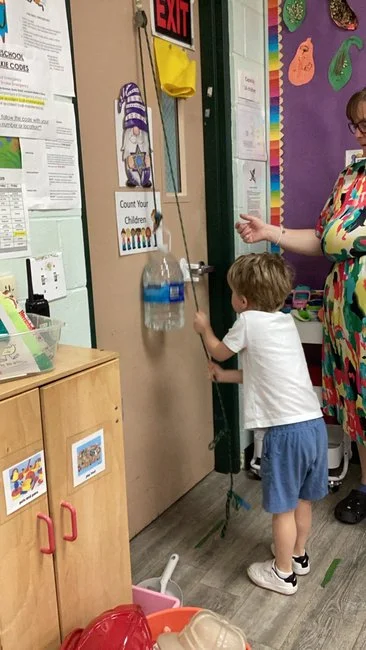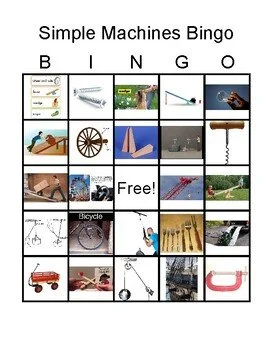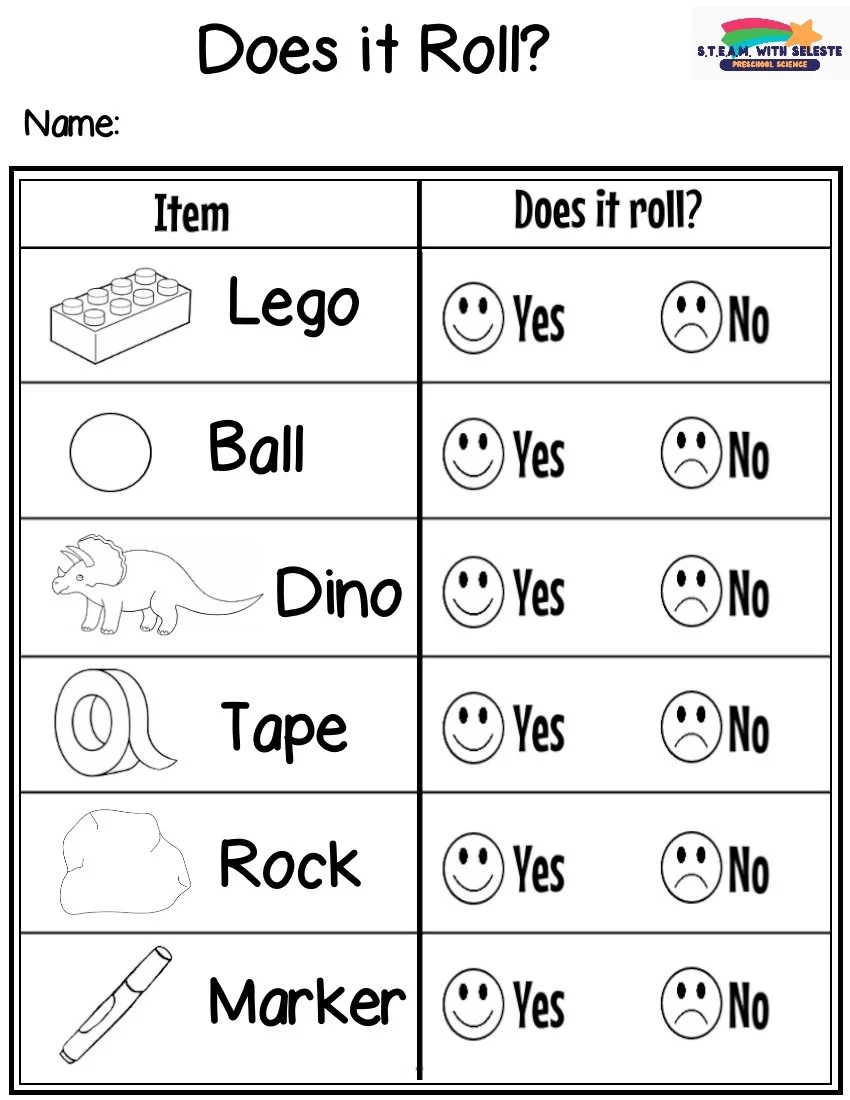The Power of Simple Machines – STEM Activities for Kids
Simple machines are a perfect way to introduce STEM and physical science to kids. In this hands-on unit, children explore how tools like levers, pulleys, and wheels make work easier—while developing problem-solving skills through fun, real-world experiments. Great for preschool, kindergarten, and early elementary classrooms, these simple machine activities support both science standards and early engineering thinking.
Ready for more hands-on STEM fun? Check out our Does It Roll? ramp experiment to extend this lesson with everyday objects.
Simple machines are the basic tools that help us do work with less effort. These machines—levers, pulleys, inclined planes, wheels and axles, screws, and wedges—can be found all around us, from playgrounds and kitchen tools to construction sites. In this lesson, children will learn how these machines change force and motion through hands-on experimentation and playful discovery. As they explore each machine, they'll begin to understand how things move, lift, push, and pull. This knowledge helps young learners connect their play to real-world tools, giving them a strong foundation in physics and problem-solving. By observing, building, and testing, children become young engineers in action.
In the STEAM Spotlight
This week’s highlight activity was all about strength—and science! Using a metal pulley from Home Depot, we created a hands-on demonstration that showed just how powerful simple machines can be. A heavy water jug was attached to a rope and pulley system, then suspended securely from a classroom door. The children were challenged to try lifting the jug straight up with their hands, then again using the pulley to raise it above their heads. Right away, they noticed how much easier it was to pull the jug using the pulley compared to lifting it without one. This led to great discussions about how simple machines help us move heavy things with less effort. The experience was both exciting and empowering, giving children a clear and physical understanding of mechanical advantage. It was a true STEAM moment—combining observation, experimentation, and engineering in action!
Want more engineering projects? Explore our Builder’s Lab activities for creative building challenges.
Exploring STEAM Stations
Does It Roll? – Ramp Science Experiment for Kids
Set up a low ramp and test a variety of classroom objects to see which ones roll. Kids can predict, test, and record their findings in this STEAM motion experiment. Use a digital download like our “Does It Roll?” printable to turn this into a full science investigation with real data tracking. Perfect for learning about force, gravity, and simple machines.
To introduce this activity, we gathered a variety of classroom items and brought them to circle time for a hands-on group experiment. One by one, we tested each item on a small ramp, asking the children to guess whether it would roll, slide, or stay put. As we observed together, students shared their predictions and reactions, building critical thinking and vocabulary in a fun, interactive way. After the demonstration, we placed a larger ramp in the block area so children could continue exploring on their own. This activity helped them notice how shapes, surfaces, and motion all work together—and gave them the chance to be scientists in action.
Bring science to life—buy the digital download for “Does It Roll?” and help kids explore motion while recording real results!
Poke Bin
In this sensory-based station, children explored how wedges work by pushing wooden golf tees into foam pool noodles. The resistance of the foam gave them tactile feedback as they applied pressure, strengthening their fine motor skills while learning about force. This simple action demonstrated how wedges work to split or cut materials, just like real tools do in the world around us. The sensory bin format added an element of quiet focus and open-ended play. Kids naturally repeated the action again and again, building both understanding and hand strength.
DIY Pulley – A Fun STEM Engineering Activity for Kids
Kids love this hands-on engineering challenge! Attach a lightweight bucket to a string and pulley system (or even a shower curtain ring) and invite children to raise and lower blocks, toys, or classroom objects. This STEM activity for preschool and early elementary students builds fine motor skills while demonstrating how pulleys make lifting easier. Encourage kids to test different weights and materials—just like real engineers!
Using everyday materials, we built a working pulley system from a recycled bottle, wooden dowel, and empty ribbon spool. Once assembled and attached to the table, the pulley became part of a dramatic play game called Whale Rescue. Kids took turns using the pulley to lift a toy whale from the "water" while a rock on the other end acted as a counterweight. This activity encouraged problem-solving, storytelling, and hands-on engineering all at once. It also reinforced how pulleys can be used in real-life situations to lift and lower heavy objects.
Rainbow Ramp Painting
In this colorful station, children raced cars and paint-covered balls down ramps set at different angles. As the balls rolled, they left unique paint trails and patterns on paper, blending art with science in a hands-on way. Teachers saved the finished artwork to decorate their classrooms, giving the science experiment a creative, lasting impact. This activity helped kids see how gravity and slope affect motion while encouraging both creativity and experimentation. It was a fun fusion of sensory play, physics, and artistic expression.
Duplo Marble Racers
By adding a special ramp kit to our Duplo blocks, children created their own marble racer tracks. This open-ended station let kids build, test, and rebuild pathways to see how fast and far marbles could travel. As they adjusted angles and track shapes, they explored the relationship between slope and speed—key concepts behind inclined planes. The activity encouraged creativity, fine motor skills, and early engineering thinking. It also gave children a fun way to see how simple machines can be integrated into building play.
Lever Ramp – Explore Force and Motion with Simple Machines
This simple machines experiment shows how levers help us lift heavier loads. Using a wooden plank, a paint stick, or a sturdy book, create a ramp with a block underneath as the fulcrum. Let kids test objects of different weights and predict which ones will move. This hands-on STEM lesson on levers introduces cause and effect, balance, and problem-solving—key concepts in early physics.
Children explored how levers work by turning a simple shelf and block into a balancing board. Working in pairs, they took turns standing on opposite sides to test balance and weight distribution. Through trial and error, they discovered how their positions and body weight affected the motion of the board. This hands-on play helped them understand the concept of a fulcrum and how levers can make balancing and lifting easier. It was a playful, full-body introduction to physics and teamwork.
Simple Machines Bingo – Printable STEM Game for the Classroom
Use Simple Machines Bingo to review key science vocabulary in a fun, engaging way. This printable STEM game reinforces the six types of simple machines while helping kids recognize them in real-world tools and toys. Great for centers, review days, or as an assessment alternative.
Books About Simple Machines
Reading books about simple machines helps children build vocabulary and deepen their understanding of science concepts in a fun and meaningful way. Stories and nonfiction texts give context to what they’re learning through play and allow them to revisit those ideas during quiet moments or read-alouds. Books also spark curiosity, prompting children to ask questions and make connections between literature and the real world.
Move It! Motion, Forces and You by Adrienne Mason
This colorful picture book introduces young children to the science of motion and force using simple language and engaging illustrations. It describes how things move, what makes them start or stop, and how force is involved in everyday play. The book uses familiar scenarios, like rolling balls or pushing swings, to explain core physics concepts in a preschool-friendly way. It’s a perfect first step into the world of simple machines.
Simple Machines by D.J. Ward
Part of the National Geographic Kids series, this nonfiction early reader uses real photographs and age-appropriate vocabulary to explore each of the six simple machines. Children learn how each tool works, where it’s used in the real world, and why it’s helpful. With bold visuals and clear examples, it reinforces classroom learning and is great for independent reading or guided discussion. The book helps bridge the gap between hands-on play and scientific explanation.
Awesome Engineering Activities for Kids by Christina Schul
This interactive book combines STEM concepts with hands-on building projects for curious kids. It introduces simple machines through experiments and real-world engineering challenges that children can try at home or in the classroom. Each activity is designed to teach a concept like force, friction, or mechanical advantage in a way that's accessible and fun. It encourages creativity, perseverance, and critical thinking—core skills for every future engineer.
Digital Downloads
Discover our collection of easy-to-use digital downloads designed to bring hands-on STEAM learning right to your home or classroom. Each printable is crafted to inspire curiosity, creativity, and critical thinking in young learners. Simply download, print, and enjoy engaging activities that support science and engineering concepts for ages 2–12. Perfect for parents, teachers, and homeschoolers looking for ready-made educational resources.
Previous Week
Next week














